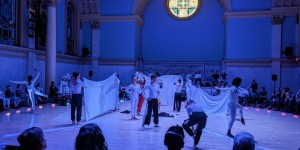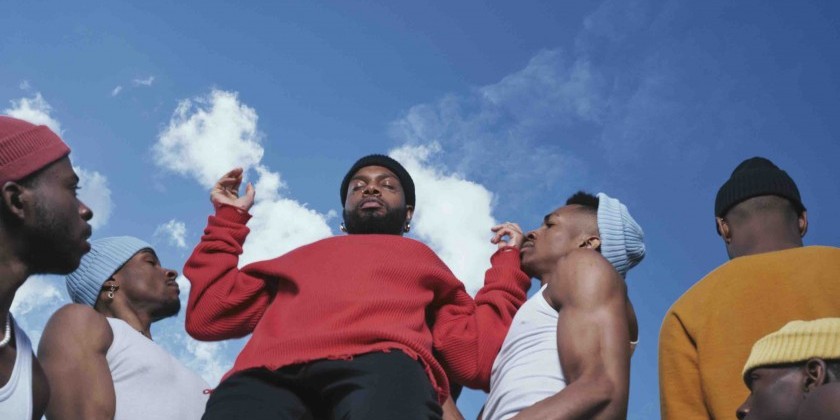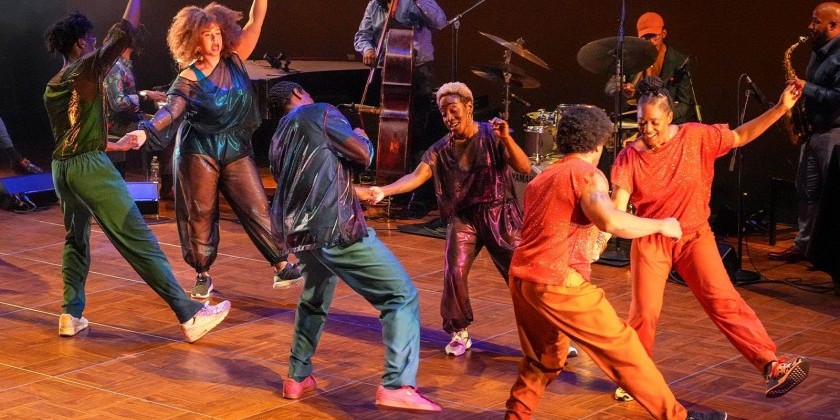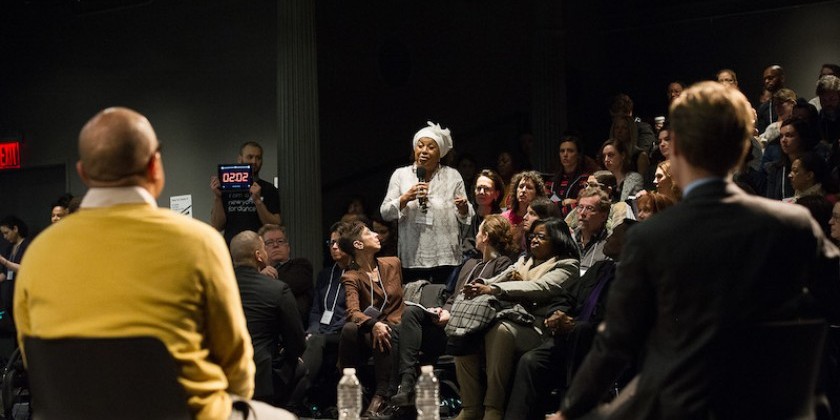The Dance Enthusiast Meets the 2015 Bessie Award Nominee Roger Guenveur Smith (Part 3)

Roger Guenveur Smith, a Bessie Nominee for Outstanding Production
It’s fall and that means temperatures are dropping, performance seasons are starting, and dancers are revving up to see who will win this year’s New York Dance & Performance Awards (The Bessies). The 2015 nominees (see list here) are what award-winning actor/director/writer Roger Guenveur Smith calls “an eclectic bunch.”
That eclecticism makes this interview series one of the most exciting of the year for me. With a blend of the usual suspects like the American Ballet Theatre and Mark Morris Dance Group positioned alongside artists like Smith, Storyboard P, and 600 HIGHWAYMEN, there is no question that New York (and even a bit of New Jersey) is a home for dance of all facets. See you on the red carpet outside the Apollo Theater in Harlem on October 19! - A. Nia Austin-Edwards, for The Dance Enthusiast
Meet 2015 Bessie Nominee for Outstanding Production for Rodney King at BRIC:
Roger Guenveur Smith adapted his Obie Award-winning solo performance of A Huey P. Newton Story into a Peabody Award-winning telefilm. His history-driven work also includes Frederick Douglass Now, Who Killed Bob Marley?, Juan And John, Christopher Columbus 1992, The Watts Towers Project, In Honor of Jean-Michel Basquiat, and, with Mark Broyard, the award-winning Inside The Creole Mafia. For Spike Lee's "Do The Right Thing", Smith created the stuttering hero Smiley. His astonishing range of film credits also includes" Malcolm X", "He Got Game", "Get On The Bus", "Eve's Bayou", "All About The Benjamins", "Hamlet", "Deep Cover" and "American Gangster", for which he was nominated for the Screen Actors' Guild Award. He starred in the HBO series "K Street", "Oz", and "Unchained Memories: Readings From The Slave Narratives".
A. Nia Austin-Edwards for The Dance Enthusiast: How did Rodney King begin? Was it an idea that had been brewing for a while? A response to a particular moment? What made you create this work?
Roger Guenveur Smith: I had referenced Rodney King for many years in my work. I’ve never used him as the butt of a joke. I had never, I don’t think, exploited him in a negative way, but I always saw Rodney King as a force of resilience. He survived the beating. And he survived up until the year 2012 the notoriety of his beating. He was a common man placed in an uncommon circumstance. He was not a high school graduate, but I feel that he delivered one of the great American speeches on May 1, 1992 when he said, quite simply “Can we, can we all get along?” And then answered his own question towards the end of the speech when he said, “Yes, we can. We can get along. We just have to work it out.” And when I opened up my laptop on Father’s Day 2012 and discovered that Rodney King had gone to the bottom of his backyard swimming pool, I was extraordinarily moved as if I had lost my blood-brother. And I wanted to know why. Why did I feel that way? And why, by extension, would my potential audience feel that, that Rodney King mattered in that way.
…As I continued to workshop the material, more information emerged about Rodney King about his demise. In fact his coroner’s report was published and streamed online. That revealed some things that were instructive to the story of Rodney King, and to his ongoing value as a moral provocateur, not unlike that other King. It was revealed that the only abnormality in Rodney King’s body was an abnormally enlarged heart. And I thought that that was significant.
I kept improvising this thing. I knew that I wanted to use Rodney King’s full speech. I wanted to interpret that because we only hear it in clips if we hear it at all. Quite frequently he is misquoted. People say, “Can we just get along?” but he never said “just.” He left it diminutive, and he answered his own question. Again, “Yes we can. We can get along.” And I knew that I wanted to quote Willie D of the Geto Boys, [using] at least a couple verses from his rap in ’92 titled “F*** Rodney King.”
…An important little rule that I created for myself in creating this improvisation is that I would not use the personal pronoun “I”. I wanted to take myself out of the equation. Even though, of course, I had all kinds of ideas about Rodney King and imagined a relationship to Rodney King. But I wanted to function as kind of a journalist…The performance [invariably] comes in at 57, 58 minutes. And that’s simply because at Bootleg it’s a indie music venue as well as a theater, so I had to finish the performance by 9pm. But I didn’t want to start earlier than 8 because we started it in August. It was still light out. That was a good challenge for me as well. And the design is similar to that because it’s a white rectangle on a black floor. So I put Rodney King in that little box, and within that box I am challenged to tell this story.

TDE: Stepping away from the work and getting to know you more – when and where does your artistic story begin? Have you always known you would be a performer, or was it more of a surprise?
RGS: No, absolutely not. I thought that I would pursue a Ph.D. in history and teach in the academy. Ironically, I wound up playing a history professor on a TV series called “A Different World.” When I started graduate school in history, I auditioned on a lark for drama school and I was accepted. I’ve been combining my interests ever since. A lot of my independent work, particularly for the stage, has been historically inspired. Rodney King is just the latest in an ongoing series of biographical and historical investigations. I do Huey Newton, Frederick Douglass, great baseball players Juan Marichal and John Roseboro in a play called Juan and John, Jean Michel Basquiat, Bob Marley, etc.
TDE: What has been the biggest challenge in your artistic journey?
RGS: I feel that the biggest challenge is always the next thing because you don’t want to repeat yourself aesthetically [or] thematically. You always want to keep stretching and changing. I think that my role models there have been in music; the great jazz musicians who continue to stretch and pull something out of a standard, like “April in Paris” or “Happy Birthday.” They’re going to continue playing it, but they’re going to play it different every time. I’ve tried to take that kind of inspiration and apply it to word performance. I think that the musicians are way ahead of us, but it’s a good standard for which to reach.
TDE: Who would you say is your artistic idol? Who constantly inspires you creatively?
RGS: Isn’t idolatry a mortal sin or something? “Thou shall not worship false idols.”
I went to a crazy concert Labor Day weekend. It was a whole bunch of great folks from New Orleans. James Andrews New Orleans All Star Band then it was The Wailers, Bob Marley’s band; then it was Sheila E.; then it was George Clinton, Parliament Funkadelic. In all of those musics I have and continue to get inspiration. It’s a tremendous mix-up. You’ve got East Bay funk from Sheila E. Latin funk. You’ve got funk comin’ out of New Orleans. You’ve got that Kingston funk, which is now being run by his great bassist Aston Garrett. They call him “Family Man.” He’s seated now playing the bass. And, of course, George Clinton – incomparable p-funk coming out of Detroit. That’s a lot of work, a lot of different sounding music but it all comes from the same source. That’s a fantastically inspiring pan-African extravaganza that continues to inspire me.
If I sat up in my house and pushed the button on my i-whatever-you-call-it, my I-and-I pad, that’s what would come out.
TDE: This fall The Dance Enthusiast is celebrating 8 years! Just for fun, can you describe your creative process in 8 words or less?
RGS: ba de bi di bop boop-bah
TDE: What do you do when you're not creating?
RGS: It’s really hot out here in LA. It’s 100°. There’s definitely going to be some water happening at some point. I’m a lion, but an aquatic lion. I must have some Pisces up in [my chart] somewhere.
TDE: Going back to that big challenge, what’s coming up next for you?
RGS: 500 Lives per Mile is a piece I’m working on which is about the construction of the Panama Canal and its cost. That’s what it cost – 500 lives per mile. And of course those were primarily workers [who were] Black men from Jamaica, Barbados, and Trinidad. [They] did that work and paid the price for the American domination of the 20th century.
I’m also working on a piece about the history of Venice, California right here in LA. It’s a beach community which has a really fascinating history.
I’m continuing to do Frederick Douglass. I’m continuing to do a duet entitled Inside the Creole Mafia with my long-time comrade Mark Broyard. We call it “a not too dark comedy.” It’s all about colorism coming out of that New Orleans tradition which was transferred here to LA. [That] is where I grew up and where Mark grew up. So we do that fine-toothed comb test, that brown paper bag test. We mix up the café au lait in a blender and we argue about how much milk should go in and how much coffee should go in. (laughs)
And I’ve had an opportunity this year to do some fantastic film work. One piece is about the Nat Turner rebellion, 1831, and it’s sardonically entitled "The Birth of A Nation written," directed by and starring Nate Parker who is a Virginian. He’s telling the quintessential Virginian story. I also did this thing called "Chiraq" with my man Spike Lee. I’m working with my old school bredren and my new school bredren. And of course I was in the Dope film this summer.
And I continue to teach and do my volunteer work with LA Works, a great organization where I am on the board.
NOTE: This is an abridged version of this interview. To read more from Smith, including his reflections on the role of performance as a manifestation of civil discourse and disobedience, check out Nia’s follow-up blog post.











